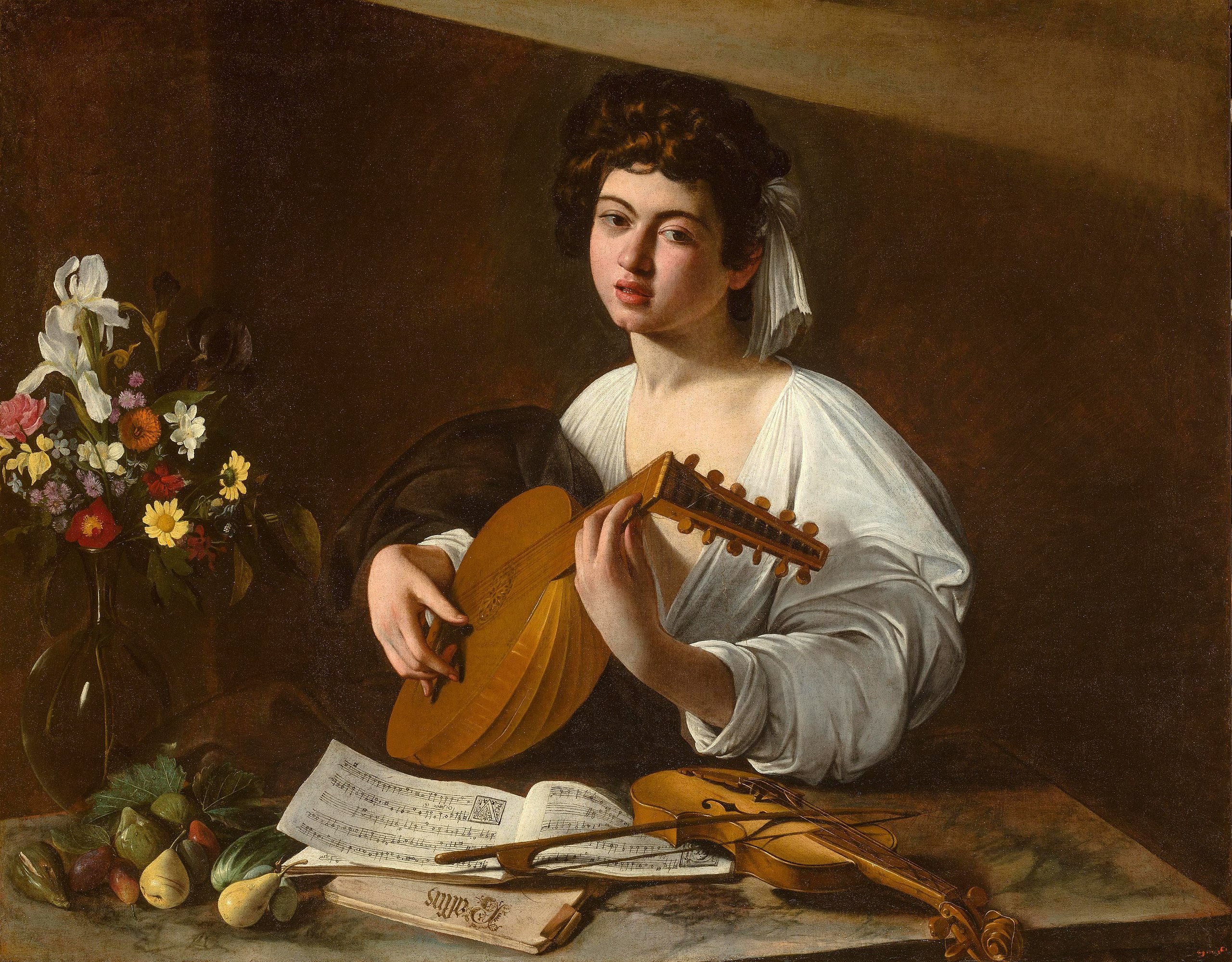HE STARES dreamily at someone over your shoulder, his mouth open and poised to sing. In his hands he strums the lute that gives him his name. Flowers decorate the desk before him. The flowing white blouse he wears is open, displaying an unusually broad rib cage and rounded shoulders. His too-boyish face and luscious curls give him a feminine appearance, making his gender and age ambiguous. He’s beautiful and mesmerizing yet somehow haunting or, perhaps, haunted.
He’s the musician in Caravaggio’s The Lute Player, suggested by some to be the Spanish castrato Pietro Montoya. No other known depictions survive of this man, who would have been in his early twenties at the time the painting was created. He probably lived in the household of the Cardinal del Monte, a patron of Caravaggio’s, while singing with the papal choir between 1592 and 1600. This period coincides with Caravaggio’s own residence within the household of del Monte. Caravaggio’s musical paintings, including The Musicians and multiple versions of The Lute Player, were all painted there.

The idea of a castrated musician sponsored by a cardinal might seem strange or even perverse to a modern reader. Yet many high-ranking figures within the church financed the training of castrati and gave them housing. The cultural phenomenon of the castrato is inextricably connected to the Catholic Church. During the European Renaissance, women were forbidden from performing on stage or singing in church. Within the Papal States, women couldn’t even sing in public. This prohibition, combined with the need for singers with high-pitched, angelic voices, led to a practice that we may regard as barbaric: the making of castrati through the destruction of a prepubescent boy’s testicles, usually by crushing, in an operation performed by specialists from Norcia, a town in central Italy.
The practice reached its height in the 17th century, when the Italian peninsula was plagued by wars, pestilence, and severe economic difficulties. Mutilating a son in the hope of producing the next great star was at times a desperate attempt to escape extreme poverty. For others, it was seen as an almost religious sacrifice—a son giving up his ability to procreate in order to produce beautiful music for the Church and to help his family.
Of course, their voices were not the only thing altered by this drastic procedure. Some castrati grew to be unusually tall, with broader rib cages and sometimes even abnormal facial bones, because their growth plates closed later than those of intact males. They kept the hair on top but could not, of course, grow a beard. Body fat tended to settle on the hips and thighs, with breasts occasionally developing as well. Many suffered from specific medical conditions, such as osteoporosis, as they aged. Before they sang a single note, their appearance marked them as different from ordinary people. Their feminine features made them easy marks for ridicule. Even the most famous and acclaimed were in many ways outcasts.
Of special interest to us, their gender-ambiguous appearance led them to be perceived as a kind of third gender. In the Early Modern period, pre-adolescent boys and girls were not gendered as strictly or as early as we do today. Gender was something one grew into with age. The castrati never grew up to become either male or female, instead remaining somewhere in between in terms of both physiology and social role. A fable from the Renaissance discussed by cultural historian Martha Feldman in The Castrato (2016) tells of a castrato who struggles to explain his gender when questioned, leading him to invent a fantastical story about being of a race of effeminate men born from eggs laid by roosters.
As in antiquity, effeminacy in men was associated with lewdness, especially toward women, causing such men to be sexualized and desired by both men and women. They were believed to be capable of sexual activity despite being infertile and may have been sexually capable in some cases. There are tales of their affairs with women, as improbable as this might seem. A legal treatise from the early 1700s made it clear that castrati could not marry, apparently in response to a woman’s desire to marry the castrato Nicolò Grimaldi. We also know that noblemen occasionally took castrati as lovers. These relationships, as music historian Roger Freitas has written, were common enough to be the object of satire.
Unlike gender-nonconforming people today, the castrati had their gender status forced upon them by a society that valued them as performers but diminished them as human beings. In this respect their status was not unlike that of many gay drag performers and transgender artists today. The latter can make a decent living and even become famous, but those venturing across gender lines, whether to entertain or to live one’s life authentically, are always risking social disapproval and even violent assault.
Caravaggio’s painting is interesting because the artist neither degrades nor glorifies his subject, the lute player. Even if the work is not specifically a portrait of Montoya, it does seem to depict a castrato. There is a naturalness to the picture that suggests empathy. Caravaggio chose to portray an intimate musical performance, neither flattering nor mocking his subject. His extraordinary, enthralling painting uniquely represents the personal charm of an individual castrato and evokes the pleasant memory of an intimate concert. Thus, for once, the gender-ambiguous outcast is humanized and treated with dignity.
Lee Lanzilotta, a transmasculine writer originally from Virginia, is currently based in Rome, Italy, where he studies Classics and archæology.





